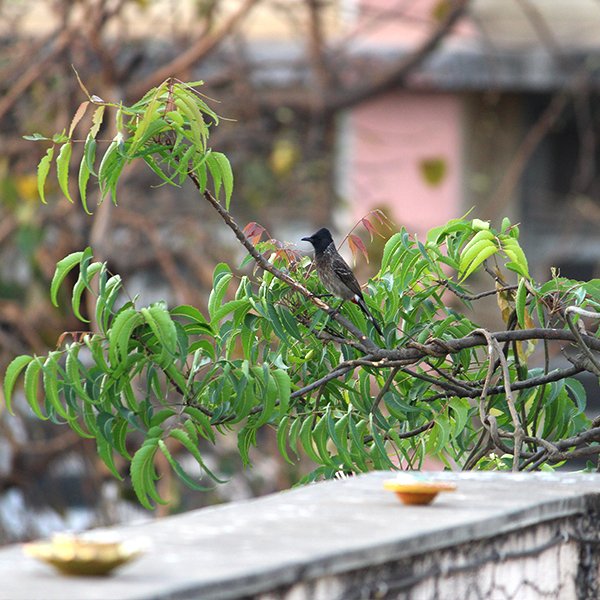They say, silence can be deafening, and I think living in a city like Mumbai – we have never really experienced the silence that the COVID-19 lockdown brought with it. It’s funny – but most comments on zoom calls were about how people could hear birds in the background instead of cars. This was a fact – the earth was healing and nature was regaining control. I’m an amateur birder, no expert; just a curious person who loves nature!

Pollution without the lockdown 
Diyas for frontline workers 
Earth healing
The Elusive Golden Oriole
On one of the first few days of the lockdown, I heard a pronounced and very odd call of a bird I had never heard before. Typically, I was used to waking up to the sounds of Koels, parrots and sparrows, but this was starkly different. So, I went to my balcony and looked up at the bare Gulmohar tree (in march the tree is completely barren). I saw the usual suspects – crows and parrots.
Suddenly, I noticed this bright shade of yellow move against the brown of the barren tree. At first, I thought it was a parrot as their tails have a streak of yellow in them. When I looked again, I saw a Golden Oriole perched on the tree. I couldn’t believe it! I had never seen a Golden Oriole in my neighborhood. Funnily enough, the first time I had seen one was in Goa a few months ago which is how I could even identify it. I quickly stumbled to get my binoculars but it was gone by the time I got back. I did spot some Asian Koels, Red-whiskered Bulbuls, Black-crowned Night Herons, Mynas and a Coppersmith Barbet. This was also the first time I had noticed a coppersmith in my area. The morning was adventurous and eventful. I felt like I was on one of my treks, watching nature wake up. This was a brilliant way to spend the mornings. The mountains were closer than I thought!

Female Asian Koel 
Coppersmith Barbet 
Black-crowned Night Heron
I woke up early the next day ready with my binoculars, telephoto lens (55-250mm) attached to my DSLR and a mobile phone, to confirm that I had, in fact spotted a Golden Oriole. Unfortunately, I didn’t end up seeing one, though I spotted a Common tailorbird, 3 Purple-rumped Sunbirds and a couple Oriental Magpie-Robins . I had never noticed the beautiful sound of the Oriental Magpie-Robin or the distinctive sound of the Coppersmith litter the mornings. In just 2 days, I had already spotted 14 species of birds from my building. I couldn’t believe it!

Purple-rumped Sunbird 
Parrots caught in the act 
Oriental Magpie-Robin
I still hadn’t spotted the Golden Oriole and as you can imagine, was determined to do so. So, I did my research using the free Ebird and Merlin app by The Cornell Lab of Ornithology, to identify the sound and find any other clue to better my chance of spotting it. As an added bonus, it also helped me identify the most likely birds to be spotted given my location and time of the year. I spent the next few days waking up early and trying to find that Golden Oriole. Although I couldn’t spot the Golden Oriole, I did sharpen my skills and learnt some valuable birding and photography lessons.
Basic lessons in birding and photography
- I realized that birds feel more comfortable around you once you have spent more time with them. This allowed me to get really close to them and get some fantastic shots.
- There are specific times in the day for spotting the maximum number of birds. Early morning between 6 am and 8:30 am was best for me. This is because I was spotting them from my terrace and the birds usually sit on top of the tree during this time to catch the morning sun. As the day progresses, they move down for some shade and come back out in the afternoon-evening.
- Certain birds prefer being higher in the tree as compared to lower and vice-versa.
- I noticed a trend of certain birds revisiting the same branches on different trees for their morning ritual. This helped me find the birds I was looking for faster as well as place myself in a position to get a better shot.
- Each bird species has a distinctive call or song, and I started developing the skill of identifying a bird with just its sound.
- The male of bird species is typically more colorful than the female
- I also figured that for photographing birds, the exposure level needs to be changed constantly, as the exposure levels which are apt in the mornings for capturing a bird sitting inside the branches of a tree is starkly different from that required when capturing one flying in the sky (max levels).
- Birds won’t typically stay in one spot for long in the morning as they are constantly on the hunt for some food. So, you have to be quick and ready to capture one on camera.
Less common birds
Finally, after 4 days of a barren, no-new-bird spotted period (although productive photography period), I see this beautiful Golden Oriole perched on top of a tree opposite my building. Before it could fly away, I took a few shots of it so that I could get my eyeful later and positively confirm its gender. I got some great shots in and that was one of the most fulfilling mornings I had had in a while. That same week I noticed some White-throated Kingfishers and a Spot-breasted Fantail Flycatcher, amongst others.

Spot-breasted Fantail Flycatcher 
The rarest sighting during lockdown! 
White-throated Kingfisher 
Golden Oriole
Flyover Birds
As time went on, I turned my attention skyward and started to spot flyover birds. I noticed Cattle Egrets, Asian Palm-Swifts, Gull-billed Terns, Indian Cormorants, Glossy Ibis and a few others. The only way I would identify them was by using my camera. Once I clicked them, I could upload the image on the Merlin App to identify and confirm the species easily. With enough sightings under my belt I was able to identify a bird in the sky with just their wing flap.

Glossy Ibis 
Indian Pond-Heron 
Swift 
Gull-Billed Tern
With the monsoon approaching, I have started to spot new species of birds. This wonder and learning will remain with me forever –
We don’t need to travel great distances for greatness; it’s within reach. Sometimes, all we have to do is look up!









One comment
Archana Karnik
Good to read about different species of birds. This article have helped me a lot to know names of birds seen in our vicinity . We too were lucky to spot golden oriole, white throated kingfisher, coppersmith barbet, fantail flycatcher, magpie robin, purple sunbirds and few more. Thankyou for such a wonderful information